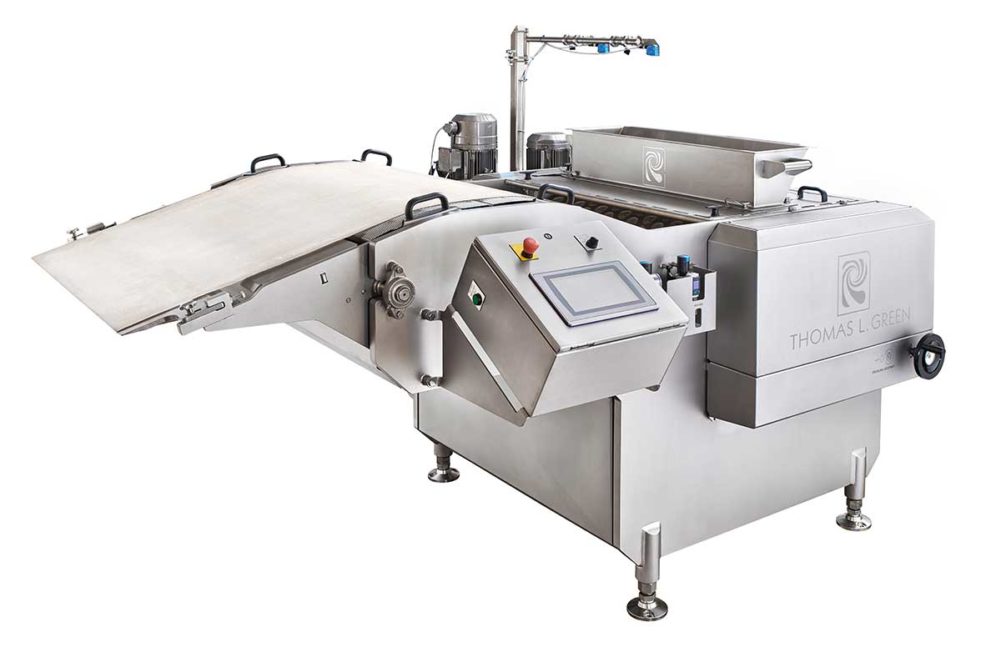Using and maintaining the right equipment makes working with better-for-you (BFY) cookie dough easier for bakers.
“The No. 1 challenge is that dense cookie dough puts a strain on the equipment both in terms of mixing, dough feeding and forming,” said Kevin Knott, technical sales manager, Bühler Inc. “Both wirecutters and extruders also. For example, if you don’t wirecut out the nozzle and you extrude and guillotine cut later, that’s also strenuous on the equipment. And rotary moulders also: It increases deflection; it increases stress in the equipment. And in a number of cases, we’ve actually had to redesign some of the drives and equipment to overcome that with bigger machines, bigger and stronger gear boxes, bigger stronger drives.”
Process consistency is key to a successful outcome when working with high-protein doughs.
“It is critical to have a good process control in place such as repeatability in the way the dough is mixed and consistency in the final dough characteristics and temperatures from batch to batch. It will save the bakers a lot of headaches in the wirecutting or forming process when dealing with difficult doughs,” said Cesar Zelaya, bakery technology manager, Handtmann Inc.
Mr. Knott emphasized the importance of keeping the dough flowing evenly through the machines.
“You have to pay attention to the design of the dough feed equipment also to make sure you have a nice, even feed of dough in the hopper of wirecutters and extruders,” he said. “That’s always been the case in the rotary moulder; it’s always been important to pay attention to that because it’s a much drier dough. With the higher fiber and protein rotary moulded doughs, once again, you have to make sure you’ve got a well-designed dough feed system with a strong kibbler to make sure you have a nice even dough pile.”
For instance, a 2,500-lb batch would need to be broken down into small enough pieces to distribute across the width of an extruder, he added.
Obtaining ideal shapes and weights also requires a consistent stream through the die and filler block, which means the wirecutter will need larger diameter rolls and a larger gap between feed rolls, said Sam Pallottini, director of cookie, cracker and pet food sales at Reading Bakery Systems.
“The same is true with rotary moulder formulations. Reading Bakery Systems offers three sizes of rotary moulders,” he added. “The correct model depends on the product’s torque requirements as well as width of the line. We encourage customers to also increase their rotary’s flexibility by going with three drives: die, forcing roll and belt.”
There used to be one motor that drove everything, he continued. It would drive the forcing roll, and then if it had a gear on it, that would drive the die roll.
“Nowadays you can add a second motor, one for the die and one for the forcing roll,” Mr. Pallottini explained. “That does two things. One, it increases your torque so you’ve got twice the gear motors. Two, it allows you to adjust the speed of the forcing roll; you can go faster or slower.”
The third component, the belt, is often driven by friction between the die and forcing roll, but Mr. Pallottini said a motor can be used to drive that roll as well, which prevents it moving even if it contains slippery materials. That minimizes the force needed between the die and rubber rolls.
“It allows you to keep it moving forward and still get the extraction you need,” he said. “It puts less force on the machine and its unique patterns. With the need for added flexibility, the three-drive system is more common these days.”
The heavier workload imposed by BFY doughs can mean that bakeries must step up maintenance.
“Thanks to equipment performance feedback provided by Handtmann Communication Unit, we have learned that denser doughs with high protein levels tend to put a heavier workload on the equipment so in cases like these we are able to closely monitor the lifetime of the wear components to determine the new proper times to carry out our recommended service intervals in the equipment,” Mr. Zelaya said.
This is especially true for older equipment that may be taxed more when handling BFY doughs.
“On older machines some bearings may need to be replaced more often, in some cases 50% more often,” Mr. Knott said. “Gear boxes need to be inspected, oil changes, etc., must be done more often. The maintenance cycles are going to be reduced unless you go to the newer designs.”
Companies interested in retrofitting machinery to accommodate BFY doughs can do this successfully sometimes, he said, adding that the horsepower of machines has gone up and down over the years.
“Now the trend because of these doughs is to go back up again,” Mr. Knott said. “So in some cases they can be rebuilt, but in a lot of cases we’ve had to replace the equipment.”
The more abrasive products can impact the lifespan of the contact components.
“This should drive the original equipment manufacturing supplier to enhance the design of the equipment to ensure components are easily accessible for hygiene and maintenance,” said Andy Green, technical development manager, Spooner Vicars, a Middleby Bakery company. “Spooner Vicars would always take these factors on board when related to equipment design.”
This article is an excerpt from the August 2021 issue of Baking & Snack. To read the entire feature on Cookies, click here.




